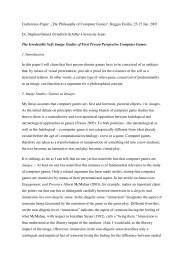Playing Dress-Up: Costumes, roleplay and imagination
Playing Dress-Up: Costumes, roleplay and imagination
Playing Dress-Up: Costumes, roleplay and imagination
You also want an ePaper? Increase the reach of your titles
YUMPU automatically turns print PDFs into web optimized ePapers that Google loves.
<strong>Playing</strong> <strong>Dress</strong>-<strong>Up</strong> Ludica<br />
Figure 8: Two There.com players in hoverpack hoop<br />
skirts duke it out with paint guns. (Image: Pearce)<br />
Figure 9: A diving helmet hoverpack in There.com.<br />
In There.com, players have managed to get around some of the design constraints presented by the<br />
template systems. Before skirts were introduced as a fashion template, players tried to manufacture them<br />
in various ways. The most common was to design pants whose legs would blend together when st<strong>and</strong>ing<br />
still, creating the appearance of a skirt or dress. (Figure 4) Another was to paint bare legs <strong>and</strong> socks on<br />
pant legs. Players also created hoop skirts out of hoverpacks. (Figure 8) Once skirts were introduced by<br />
management, they were among the most highly coveted <strong>and</strong> expensive fashion items, <strong>and</strong> are now<br />
available in a variety of lengths. Players have also created unusual costumes using similar kluges, such as<br />
a diving helmet hoverpack. (Figure 9)<br />
These examples allow us to better underst<strong>and</strong> the mechanics of costume play in digital games <strong>and</strong> virtual<br />
worlds. In the next section, we will discuss various cultural practices of costume <strong>and</strong> dress-up play <strong>and</strong><br />
their implications in the digital sphere.<br />
Childhood <strong>and</strong> Adulthood/Play <strong>and</strong> Ritual<br />
To be myself ... I need the illumination of other people's eyes, <strong>and</strong> therefore cannot be entirely sure<br />
what is my self.<br />
—Bernard from Virginia Woolf's The Waves (1931)<br />
One of the most notable shifts in the practice of costume play is its increasing popularity, in both analog<br />
<strong>and</strong> digital form, among adults in the U.S. While an integral part of many nonwestern rituals, the<br />
pleasures of dress-up have typically been barred to adults in modern Western culture, except in a small<br />
h<strong>and</strong>ful of explicitly approved situations such as Halloween, masquerade balls <strong>and</strong> historical<br />
reenactments. The situation differs in Japan, where “cosplay”—a contraction of the words costume <strong>and</strong><br />
play—has become a popular <strong>and</strong> socially acceptable pastime. (Figure 10) It is not unusual to see Japanese<br />
young adults dressed in outfits derived from anime <strong>and</strong> manga characters, elaborate gothic Lolitas, <strong>and</strong><br />
more recently subjects from fantasy film, television <strong>and</strong> video games. Mizuki Ito, who studies children<br />
<strong>and</strong> popular culture in Japan, describes the situation there: “In more recent years, cyberspace <strong>and</strong> inner<br />
space has come to occupy a similar role in the imaginary of Japanese popular culture.” (Ito, 2005, p.1)<br />
Further, she asks, “How do marginal <strong>and</strong> fantastic imaginaries function as sites of alternative cultural<br />
Philosophy of Computer Games 2007 Page 10






